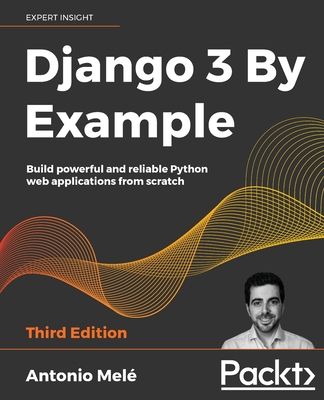Hands-On RESTful Python Web Services: Develop RESTful web services or APIs with modern Python 3.7, 2nd Edition
暫譯: 實作 RESTful Python 網路服務:使用現代 Python 3.7 開發 RESTful 網路服務或 API(第二版)
Gaston C. Hillar
- 出版商: Packt Publishing
- 出版日期: 2018-12-26
- 售價: $1,990
- 貴賓價: 9.5 折 $1,891
- 語言: 英文
- 頁數: 500
- 裝訂: Paperback
- ISBN: 1789532221
- ISBN-13: 9781789532227
-
相關分類:
Python、程式語言
海外代購書籍(需單獨結帳)
買這商品的人也買了...
-
 TCP/IP 互連網路 (Internetworking with TCP/IP: Principles, Protocols, and Architecture, 5/e)
TCP/IP 互連網路 (Internetworking with TCP/IP: Principles, Protocols, and Architecture, 5/e)$550$495 -
 $1,584OpenGL ES 2.0 Programming Guide (Paperback)
$1,584OpenGL ES 2.0 Programming Guide (Paperback) -
 OpenGL Shading Language, 3/e (Paperback)
OpenGL Shading Language, 3/e (Paperback)$2,360$2,242 -
 精通 Python 3 程式設計, 2/e (Programming in Python 3: A Complete Introduction to the Python Language, 2/e)
精通 Python 3 程式設計, 2/e (Programming in Python 3: A Complete Introduction to the Python Language, 2/e)$680$537 -
 王者歸來-HTML5 與 CSS 3 權威指南
王者歸來-HTML5 與 CSS 3 權威指南$580$493 -
 王者歸來-Android 開發權威指南
王者歸來-Android 開發權威指南$590$502 -
 王者歸來-征服 JavaScript
王者歸來-征服 JavaScript$780$663 -
 Learn Objective-C on the Mac: For OS X and iOS, 2/e (Paperback)
Learn Objective-C on the Mac: For OS X and iOS, 2/e (Paperback)$1,720$1,634 -
 8051 單晶片 C 語言入門與實作
8051 單晶片 C 語言入門與實作$430$387 -
 ShiVa 3D App 遊戲設計實戰
ShiVa 3D App 遊戲設計實戰$620$527 -
 $1,480Windows 8 Apps with XAML and C# Unleashed (Paperback)
$1,480Windows 8 Apps with XAML and C# Unleashed (Paperback) -
 精通 Android 程式介面設計-打造最佳使用者體驗的 App
精通 Android 程式介面設計-打造最佳使用者體驗的 App$560$442 -
 $653C++ Primer, 5/e (簡體中文版)
$653C++ Primer, 5/e (簡體中文版) -
 $301Clojure 數據分析秘笈/大數據技術叢書
$301Clojure 數據分析秘笈/大數據技術叢書 -
 $658OpenGL編程指南(原書第8版) (OpenGL Programming Guide: The Official Guide to Learning OpenGL, Version 4.3, 8/e)
$658OpenGL編程指南(原書第8版) (OpenGL Programming Guide: The Official Guide to Learning OpenGL, Version 4.3, 8/e) -
 $245Living Clojure (中文版)
$245Living Clojure (中文版) -
 $403深度學習 : 21天實戰 Caffe
$403深度學習 : 21天實戰 Caffe -
 精通 Go 程式設計 (The Go Programming Language)
精通 Go 程式設計 (The Go Programming Language)$580$493 -
 $352區塊鏈技術指南
$352區塊鏈技術指南 -
 $250Maven 應用實戰
$250Maven 應用實戰 -
 $426NoSQL 數據庫入門與實踐 (基於MongoDB\Redis)
$426NoSQL 數據庫入門與實踐 (基於MongoDB\Redis) -
 奔跑吧!Linux kernel|Linux 4.x kernel 關鍵與原始程式碼解析
奔跑吧!Linux kernel|Linux 4.x kernel 關鍵與原始程式碼解析$880$695 -
 C++17 教學範本, 5/e (Beginning C++17, 5/e)
C++17 教學範本, 5/e (Beginning C++17, 5/e)$880$695 -
 Mastering Linux Device Driver Development: Write custom device drivers to support computer peripherals in Linux operating systems (Paperback)
Mastering Linux Device Driver Development: Write custom device drivers to support computer peripherals in Linux operating systems (Paperback)$1,980$1,881 -
 $556CentOS 8 Linux 系統管理與一線運維實戰
$556CentOS 8 Linux 系統管理與一線運維實戰
商品描述
Explore the best tools and techniques to create lightweight, maintainable, and scalable Python web services
Key Features
- Combine Python with different data sources to build complex RESTful APIs from scratch
- Configure and fine-tune your APIs using the best tools and techniques available
- Use command-line and GUI tools to test CRUD operations performed by RESTful Web Services or APIs
Book Description
Python is the language of choice for millions of developers worldwide that builds great web services in RESTful architecture. This second edition of Hands-On RESTful Python Web Services will cover the best tools you can use to build engaging web services.
This book shows you how to develop RESTful APIs using the most popular Python frameworks and all the necessary stacks with Python, combined with related libraries and tools. You'll learn to incorporate all new features of Python 3.7, Flask 1.0.2, Django 2.1, Tornado 5.1, and also a new framework, Pyramid. As you advance through the chapters, you will get to grips with each of these frameworks to build various web services, and be shown use cases and best practices covering when to use a particular framework.
You'll then successfully develop RESTful APIs with all frameworks and understand how each framework processes HTTP requests and routes URLs. You'll also discover best practices for validation, serialization, and deserialization. In the concluding chapters, you will take advantage of specific features available in certain frameworks such as integrated ORMs, built-in authorization and authentication, and work with asynchronous code. At the end of each framework, you will write tests for RESTful APIs and improve code coverage.
By the end of the book, you will have gained a deep understanding of the stacks needed to build RESTful web services.
What you will learn
- Select the most appropriate framework based on requirements
- Develop complex RESTful APIs from scratch using Python
- Use requests handlers, URL patterns, serialization, and validations
- Add authentication, authorization, and interaction with ORMs and databases
- Debug, test, and improve RESTful APIs with four frameworks
- Design RESTful APIs with frameworks and create automated tests
Who this book is for
This book is for web developers who have a working knowledge of Python and would like to build amazing web services by taking advantage of the various frameworks of Python. You should have some knowledge of RESTful APIs.
Table of Contents
- Developing RESTful APIs and Microservices with Flask 1.0.2
- Working with Models, SQLAlchemy, and Hyperlinked APIs in Flask
- Improving API and Adding Authentication to it with Flask
- Testing and Deploying an API in a Microservice with Flask
- Developing RESTful APIs with Django 2.1
- Working with Class-based Views and Hyperlinked APIs in Django 2.1
- Improving our API and Adding Authentication to it with Django
- Throttling, Filtering, Testing, and Deploying an API with Django 2.1
- Developing RESTful APIs with Pyramid 1.10
- Developing RESTful APIs with Tornado 5.1.1
- Working with Asynchronous Code, Testing, and Deploying an API with Tornado
商品描述(中文翻譯)
探索創建輕量級、可維護且可擴展的 Python 網路服務的最佳工具和技術
主要特點
- 結合 Python 與不同數據來源,從零開始構建複雜的 RESTful API
- 使用最佳工具和技術配置和微調您的 API
- 使用命令行和 GUI 工具測試 RESTful 網路服務或 API 執行的 CRUD 操作
書籍描述
Python 是全球數百萬開發者的首選語言,用於構建出色的 RESTful 架構網路服務。本書《實作 RESTful Python 網路服務》的第二版將涵蓋您可以用來構建引人入勝的網路服務的最佳工具。
本書將向您展示如何使用最受歡迎的 Python 框架和所有必要的堆疊來開發 RESTful API,並結合相關的庫和工具。您將學習整合 Python 3.7、Flask 1.0.2、Django 2.1、Tornado 5.1 的所有新特性,以及一個新框架 Pyramid。隨著章節的深入,您將掌握這些框架以構建各種網路服務,並展示使用案例和最佳實踐,說明何時使用特定框架。
然後,您將成功開發所有框架的 RESTful API,並了解每個框架如何處理 HTTP 請求和路由 URL。您還將發現驗證、序列化和反序列化的最佳實踐。在最後幾章中,您將利用某些框架中可用的特定功能,例如集成的 ORM、內建的授權和身份驗證,並處理非同步代碼。在每個框架的結尾,您將為 RESTful API 編寫測試並提高代碼覆蓋率。
到書籍結束時,您將深入了解構建 RESTful 網路服務所需的堆疊。
您將學到的內容
- 根據需求選擇最合適的框架
- 使用 Python 從零開始開發複雜的 RESTful API
- 使用請求處理器、URL 模式、序列化和驗證
- 添加身份驗證、授權,並與 ORM 和數據庫互動
- 使用四個框架調試、測試和改進 RESTful API
- 設計 RESTful API 並創建自動化測試
本書適合對象
本書適合對 Python 有一定工作知識的網頁開發者,並希望利用 Python 的各種框架構建出色的網路服務。您應該對 RESTful API 有一些了解。
目錄
1. 使用 Flask 1.0.2 開發 RESTful API 和微服務
2. 在 Flask 中使用模型、SQLAlchemy 和超鏈接 API
3. 改進 API 並使用 Flask 添加身份驗證
4. 在微服務中測試和部署 API
5. 使用 Django 2.1 開發 RESTful API
6. 在 Django 2.1 中使用基於類的視圖和超鏈接 API
7. 改進我們的 API 並使用 Django 添加身份驗證
8. 使用 Django 2.1 限流、過濾、測試和部署 API
9. 使用 Pyramid 1.10 開發 RESTful API
10. 使用 Tornado 5.1.1 開發 RESTful API
11. 在 Tornado 中處理非同步代碼、測試和部署 API














